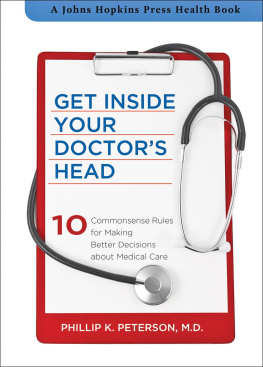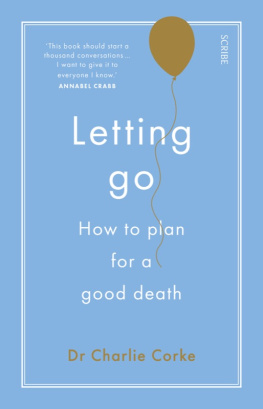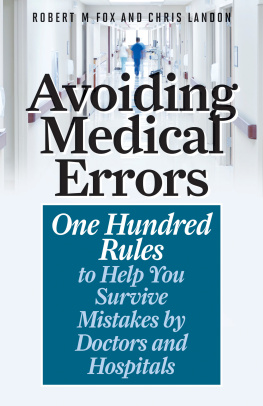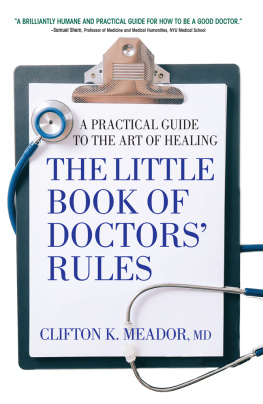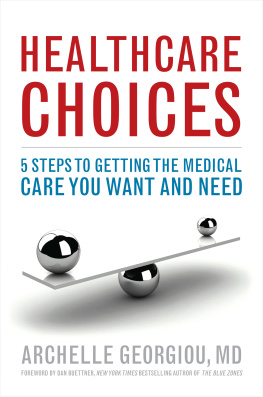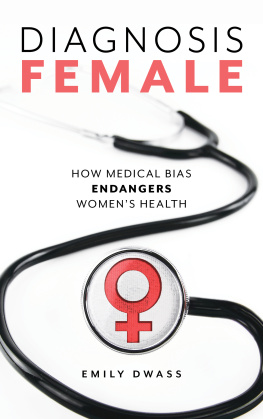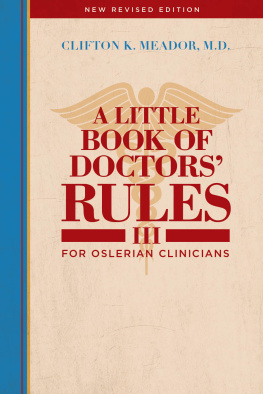
Get Inside Your Doctors Head
A Johns Hopkins Press Health Book
Get Inside Your Doctors Head
10 Commonsense Rules for Making Better Decisions about Medical Care
Phillip K. Peterson, M.D.

Note to the reader . This is a book of general guidance to help you work together with your physician to make your own best medical decisions. It is not intended to be used to diagnose or treat any symptom, illness, or condition. If you have a symptom, illness, or condition, please consult a qualified health care professional.
2013 Phillip K. Peterson
All rights reserved. Published 2013
Printed in the United States of America on acid-free paper
9 8 7 6 5 4 3 2 1
The Johns Hopkins University Press
2715 North Charles Street
Baltimore, Maryland 21218-4363
www.press.jhu.edu
Library of Congress Cataloging-in-Publication Data
Peterson, Phillip K.
Get inside your doctors head : ten commonsense rules for making better decisions about medical care / Phillip K. Peterson, M.D.
pages cm (A Johns Hopkins Press health book ; 33)
ISBN-13: 978-1-4214-1069-2 (hardcover : alk. paper)
ISBN-10: 1-4214-1069-9 (hardcover : alk. paper)
ISBN-13: 978-1-4214-1070-8 (electronic)
ISBN-10: 1-4214-1070-2 (electronic)
1. Patient education. 2. Patient participation. 3. MedicineDecision making. 4. Physician and patient. I. Title.
R727.4.P46 2013
613dc23 2012050895
A catalog record for this book is available from the British Library.
Special discounts are available for bulk purchases of this book. For more information, please contact Special Sales at 410-516-6936 or specialsales@press.jhu.edu .
The Johns Hopkins University Press uses environmentally friendly book materials, including recycled text paper that is composed of at least 30 percent post-consumer waste, whenever possible.
To Karin, Kirstin, and Per
Believe nothing, no matter where you read
it or who has said it, not even if I have said
it, unless it agrees with your own reason
and your own common sense .
Buddha (563483 BCE)
Contents
Get Inside Your Doctors Head
Introduction
Applying and Breaking the Rules
I am an infectious disease doctor. I treat people who are sick with diseases that spread from one person to another person or, in some casessuch as swine flufrom an animal to a person. In the forty years since I took the Hippo-cratic Oath, the medical world has been transformed through breathtaking advances in medical science. And the wider world has seen a transformation, too: computer and Internet technology have put a wealth of information at everyones fingertips. While access to this information can be extremely helpful, many of my patients find it daunting, if not overwhelming. They need tools to simplify their medical decisions. This book provides such tools, called the Ten Rules of Internal Medicine.
The Rules provide simple direction whenever a patient or family member is faced with a medical decision. Originally intended to help simplify doctors decisions, they are equally helpful for laypeople. You can turn to them when you are weighing your doctors recommendations about diagnostic tests and treatments. They can also help you communicate more effectively with your doctor.
When I completed internal medicine training in 1975, decision making was simple. By and large, patients trusted their doctors to make the right decisions for them. During my training, I was told by a respected internist that most of the patients who came to his office were the worried well. By this he meant they had nothing seriously wrong with them.
Today, these two things havent changed. Most people still trust in their doctors and are worried when they see their doctors, whether they feel well or ill. What has changed is the process of decision makingand it has changed dramatically. The authoritarian approach of your doctor knows best is gone. Fortunately, we are in an era of shared decision making.
Yet, paradoxically, as science advances, so does the difficulty of making medical decisions: we know more, and there are more options to consider. Furthermore, because information is instantaneously available via the Internet, patients are awash in information, both reliable and not reliable. For these reasons, making decisions about health care has become a nightmare for many people.
To help patients, some hospitals now provide decision-making services, including decision-making coaches. By revealing the complexity of medical decisions, however, these efforts sometimes make matters worse. When we have too much information, our ability to make the best decision may actually deteriorate.
This book will help simplify your medical decisions. It is built upon two premises. First, knowing something about how your doctor arrives at recommendations is extremely helpful (which is why this book is called Get Inside Your Doctors Head ). Second, common sense, the basis for each of the Ten Rules of Internal Medicine, should guide all medical decisions.
The Ten Rules of Internal Medicine
If you dont know what youre doing, dont do anything. |
If what youre doing seems to be working, think about continuing it. |
If what youre doing doesnt seem to be working, think about doing something else. |
Dont agree to an invasive procedure without understanding why its neededand without getting a second opinion. |
If you dont have symptoms, a doctor cant make you feel better. |
Never trust anyone completely, especially purveyors of conventional wisdom. |
Most things are what they seem to be, except when theyre not. |
What your doctor doesnt know could kill you. |
Timing is everything, and sometimes time is the cure. |
Caring is always important medicine. |
Over the past several decades, with input from mentors in infectious diseases and from students and patients, I developed the Ten Rules.
You cannot put the same shoe on every foot.
Publilius Syrus (8543 BCE)
The wording of most of the Rules is exactly the same for doctors and patients, but some (Rules 4, 5, and 8) focus on you, the patient, as the decision maker.
Your doctor knows that patients rarely fit the exact textbook description of any medical problem. Yet most guides to medical decision making are rooted in the view that decisions should be backed by solid evidence. So-called evidence-based medicine, or EBM, is grounded in the statistical analysis of data from studies of groups of patients with a given disease. But in clinical practice, we rarely see a patient who perfectly fits the description of a group of patients. As Jerome Groopman observes in his book How Doctors Think , Statistics cannot substitute for the human being before you. Thus, your doctors assessment and recommendations should be based not only on EBM but also on your clinical, emotional, cultural, and social circumstances.
As with all rules, the Ten Rules of Internal Medicine have occasional exceptionsand when evidence suggests that you are such an exception, the relevant Rule should be broken. In each chapter of this book, I describe circumstances that fit the relevant Rules, as well as more unusual circumstances that necessitate breaking them.
The Ten Rules may also be useful when you are faced with nonmedical decisions. I provide some illustrations of how the Rules can help in everyday life.
Next page
